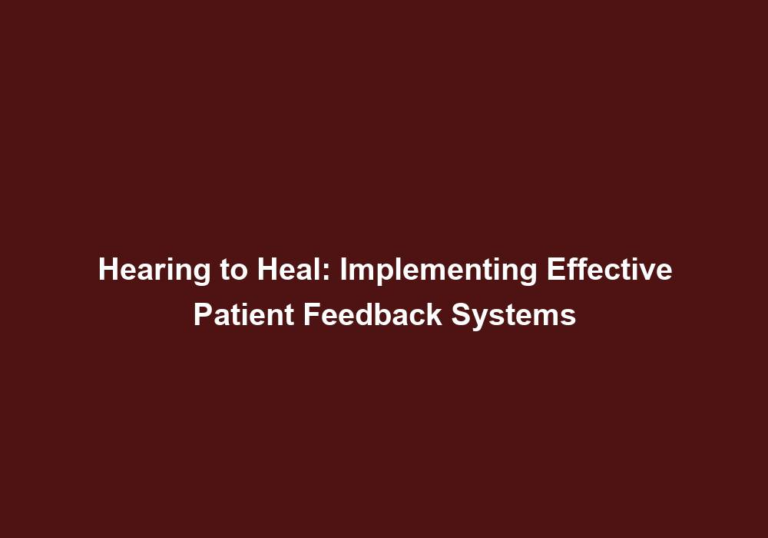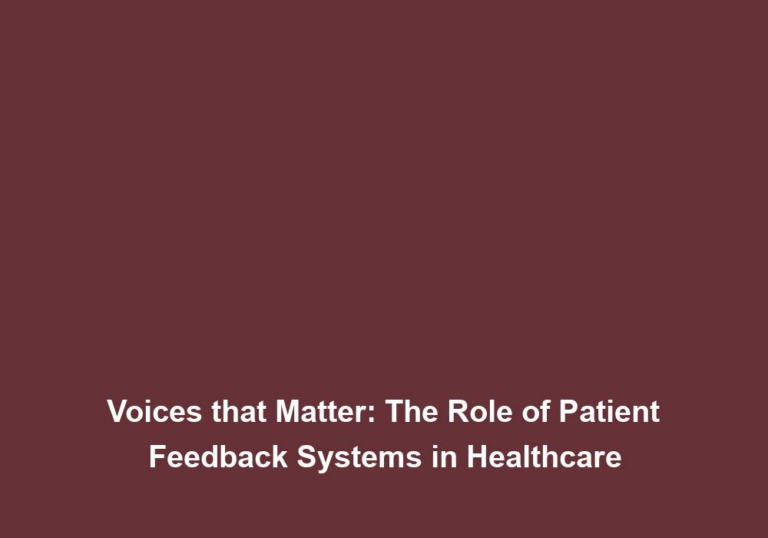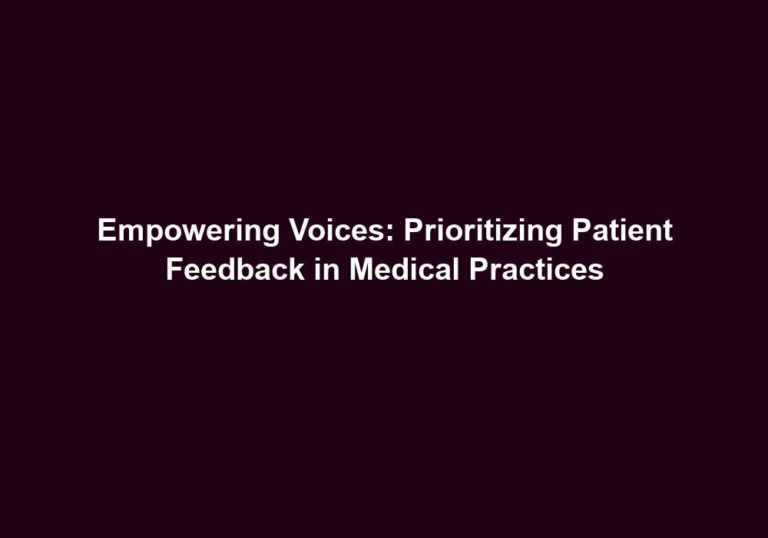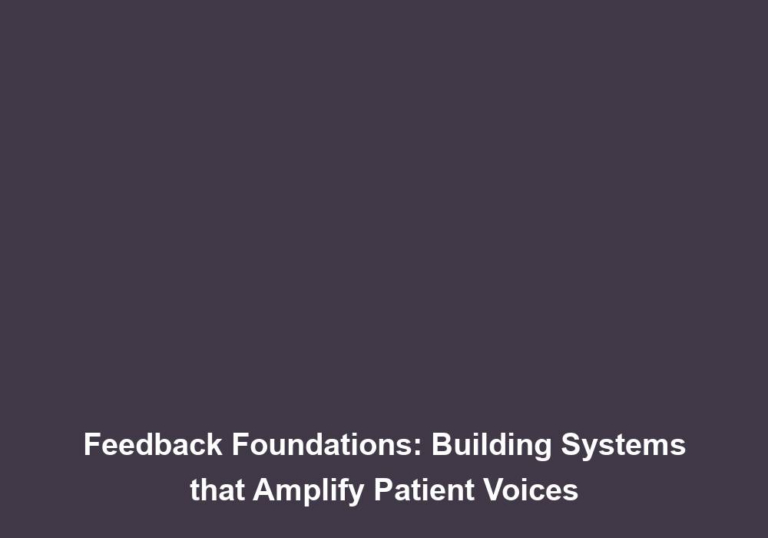From Comments to Care: Transforming Patient Feedback into Actionable Insights
In the ever-evolving healthcare industry, patient feedback holds immense value in driving improvements and delivering exceptional care experiences. Every comment, suggestion, or complaint shared by a patient is a treasure trove of insights that can guide healthcare providers in optimizing their services. By effectively transforming patient feedback into actionable insights, healthcare organizations can enhance care delivery, improve patient satisfaction, and ultimately achieve better outcomes.
The Importance of Patient Feedback
Patient feedback serves as a powerful tool for healthcare providers to evaluate their performance, identify areas of improvement, and prioritize strategies for enhancing patient experiences. By actively listening to patients and valuing their opinions, healthcare organizations can foster a patient-centered culture and ensure that the care they provide aligns with patient expectations.
- Enhancing Service Quality: Patient feedback enables healthcare providers to evaluate the quality of their services from the perspective of those who receive them. It helps identify gaps in care delivery, recognize strengths and weaknesses, and implement strategies to enhance service quality.
-
Understanding patients’ experiences: Patient feedback allows healthcare providers to gain insights into patients’ experiences with their services. It helps them identify areas where patients may have encountered difficulties or experienced exceptional care. By understanding these experiences, providers can make targeted improvements to enhance service quality.
-
Identifying improvement opportunities: Through patient feedback, healthcare organizations can identify specific areas that require improvement. Whether it’s addressing long waiting times, improving communication, or enhancing the cleanliness of facilities, patient feedback provides valuable information for prioritizing improvement initiatives.
-
Recognizing provider strengths: Patient feedback not only highlights areas that need improvement but also sheds light on provider strengths. By recognizing and reinforcing these strengths, healthcare organizations can ensure that they continue to deliver exceptional care in those areas.
- Building Patient Trust: Actively seeking and incorporating patient feedback demonstrates a commitment to patient-centered care. When patients feel heard and their concerns are addressed, it builds trust and strengthens the patient-provider relationship.
-
Creating a safe space for feedback: By actively encouraging patients to provide feedback, healthcare organizations create a safe space for open communication. This fosters trust and ensures that patients feel comfortable sharing their thoughts and concerns.
-
Addressing patient concerns: Patient feedback provides an opportunity for healthcare providers to address any issues or concerns raised by patients. By promptly acknowledging and resolving these concerns, providers can show their dedication to patient satisfaction and further strengthen trust.
-
Improving transparency: Incorporating patient feedback into decision-making processes and openly communicating the actions taken based on feedback enhances transparency. This transparency helps build trust by demonstrating that patient feedback is valued and acted upon.
- Driving Continuous Improvement: Patient feedback acts as a catalyst for continuous improvement initiatives. By analyzing and acting upon feedback, healthcare organizations can identify recurring issues, implement corrective measures, and continually refine their processes to provide better care experiences.
-
Identifying trends and patterns: Patient feedback, when analyzed systematically, can reveal trends and patterns in the quality of care. By identifying these trends, healthcare providers can address underlying issues and implement system-wide improvements.
-
Engaging staff in improvement efforts: Involving healthcare staff in the feedback analysis process encourages a culture of continuous improvement. By engaging staff, organizations can tap into their expertise and insights to develop effective strategies for addressing areas that need improvement.
-
Measuring the impact of interventions: Patient feedback allows healthcare organizations to assess the effectiveness of interventions implemented to address specific issues. By monitoring feedback after implementing changes, providers can determine if the interventions have had the desired impact and make further adjustments if needed.
Strategies for Collecting Patient Feedback
To effectively transform patient feedback into actionable insights, healthcare providers must establish robust mechanisms for collecting feedback. Here are some strategies that can help:
1. Surveys and Questionnaires
Surveys and questionnaires are commonly used tools to gather patient feedback. They can be administered through various channels such as email, online platforms, or even within healthcare facilities. The key is to design surveys that capture relevant information and provide patients with an easy and convenient way to share their opinions.
-
Designing effective surveys: When creating surveys, healthcare providers should ensure that the questions are clear, concise, and cover the relevant aspects of the patient experience. By using a combination of closed-ended and open-ended questions, providers can gather both quantitative and qualitative data.
-
Personalizing surveys: Tailoring surveys to the specific needs and characteristics of the patient population can lead to more meaningful feedback. By considering factors such as age, language preferences, or specific medical conditions, providers can enhance the relevance and accuracy of the feedback received.
-
Providing multiple feedback channels: Offering various channels for patients to provide feedback, such as online platforms, phone hotlines, or in-person suggestion boxes, ensures accessibility and accommodates different patient preferences.
2. Focus Groups and Interviews
Focus groups and interviews provide an opportunity for in-depth discussions with patients. These qualitative methods allow healthcare providers to delve deeper into specific topics, uncovering valuable insights and understanding patients’ experiences in greater detail. It is important to ensure a comfortable and non-judgmental environment to encourage open and honest dialogue.
-
Selecting diverse participants: When conducting focus groups or interviews, it is essential to include a diverse range of participants to capture different perspectives. This diversity can help identify unique insights and ensure that feedback represents the broader patient population.
-
Using skilled facilitators: Skilled facilitators can guide focus group discussions or interviews, ensuring that participants feel comfortable sharing their experiences and opinions. Facilitators should possess good communication skills, active listening abilities, and the ability to probe deeper into responses.
-
Analyzing qualitative data: Analyzing qualitative data from focus groups and interviews may involve categorizing responses based on themes, identifying common patterns, and extracting key insights. This analysis can provide a rich understanding of patients’ experiences and inform targeted improvement strategies.
3. Real-Time Feedback Systems
Implementing real-time feedback systems, such as digital kiosks or mobile applications, enables patients to provide feedback immediately after their interactions with healthcare providers. This approach eliminates potential biases associated with delayed feedback and allows for prompt action to address any concerns raised.
-
Streamlining feedback collection: Real-time feedback systems provide a convenient and efficient way for patients to share their experiences without the need for additional paperwork or follow-up. By streamlining the feedback collection process, healthcare organizations can encourage more patients to participate and provide timely feedback.
-
Promptly addressing concerns: Real-time feedback systems enable healthcare providers to identify and address concerns in a timely manner. By promptly responding to feedback, providers can show their commitment to patient satisfaction and prevent issues from escalating.
-
Monitoring real-time feedback trends: Analyzing real-time feedback data can help healthcare organizations identify emerging trends or recurring issues. By monitoring these trends, providers can proactively address them and make necessary improvements to enhance patient experiences.
4. Social Media Monitoring
Monitoring social media platforms for patient comments, reviews, and posts can provide valuable insights into patient experiences and sentiments. Healthcare organizations can leverage social media listening tools to track and analyze mentions, identify trends, and engage with patients directly to address their concerns or acknowledge positive feedback.
-
Implementing social media listening tools: Social media listening tools allow healthcare providers to monitor online conversations about their organization, services, or specific healthcare experiences. These tools can help identify sentiment, track trends, and gather feedback from a wider audience.
-
Responding to social media feedback: Engaging with patients on social media platforms demonstrates a proactive approach to addressing feedback. Healthcare organizations can respond to comments, acknowledge positive experiences, and offer support or solutions to concerns expressed online.
-
Leveraging positive feedback for reputation management: Positive feedback shared on social media platforms can be used to enhance the organization’s reputation. By highlighting positive patient experiences, healthcare providers can attract new patients and build trust in their services.
Analyzing Patient Feedback
Collecting patient feedback is only the first step; the real value lies in analyzing and transforming this feedback into actionable insights. Here are some techniques to effectively analyze patient feedback:
- Natural Language Processing (NLP): Utilizing NLP technology allows healthcare providers to analyze large volumes of unstructured patient feedback data, such as comments or free-text responses. NLP algorithms can identify themes, sentiment, and extract key insights, enabling providers to gain a comprehensive understanding of patient experiences.
-
Identifying themes and patterns: NLP algorithms can analyze patient feedback to identify recurring themes and patterns. By categorizing feedback into themes such as communication, wait times, or cleanliness, healthcare providers can focus on specific areas for improvement.
-
Extracting sentiment analysis: NLP algorithms can determine the sentiment expressed in patient feedback, whether it is positive, negative, or neutral. This sentiment analysis helps providers gauge overall patient satisfaction and identify areas that require immediate attention.
-
Uncovering insights from unstructured data: Patient feedback often contains unstructured data, such as open-ended comments or free-text responses. NLP algorithms can extract key insights from this unstructured data, providing a deeper understanding of patients’ experiences and concerns.
- Sentiment Analysis: Sentiment analysis involves classifying patient feedback as positive, negative, or neutral. By categorizing sentiments, healthcare providers can identify areas that require improvement or areas where they excel. Sentiment analysis can be performed manually or automated using machine learning algorithms.
-
Manual sentiment analysis: Manual sentiment analysis involves reading and interpreting patient feedback to determine the underlying sentiment. This approach allows for a more nuanced understanding of patients’ experiences but can be time-consuming for large volumes of feedback.
-
Automated sentiment analysis: Automated sentiment analysis uses machine learning algorithms to classify patient feedback into positive, negative, or neutral sentiments. This approach allows for efficient analysis of large datasets and provides a quick overview of overall sentiment trends.
-
Combining manual and automated analysis: Combining manual and automated sentiment analysis can provide a comprehensive view of patient sentiment. Manual analysis can capture nuances and context, while automated analysis can handle larger volumes of feedback.
- Quantitative Analysis: Quantitative analysis involves aggregating and analyzing numerical data collected through rating scales or Likert-type questionnaires. This approach provides statistical insights and allows for benchmarking against industry standards or organizational targets.
-
Statistical analysis: Quantitative analysis involves using statistical techniques to analyze numerical data, such as calculating averages, percentages, or correlations. This analysis provides objective insights into patient feedback and allows for comparisons over time or between different healthcare providers.
-
Benchmarking against standards: Quantitative analysis enables healthcare providers to benchmark their performance against industry standards or internal targets. By comparing feedback scores to established benchmarks, providers can identify areas where they are excelling or falling behind.
-
Identifying correlations and trends: Quantitative analysis can uncover correlations between different aspects of patient feedback, such as the relationship between wait times and overall satisfaction. By identifying these correlations and trends, healthcare organizations can prioritize improvement efforts strategically.
Transforming Feedback into Actionable Insights
Once patient feedback has been collected and analyzed, it is crucial to translate it into actionable insights that drive meaningful change. Here are some steps to ensure feedback is effectively utilized:
- Identify Priorities: Based on the analysis, prioritize areas or themes that require immediate attention. Focus on aspects that significantly impact patient experiences or have the potential to drive substantial improvements.
-
Triaging feedback: By categorizing feedback based on urgency and impact, healthcare providers can identify high-priority areas that require immediate attention. This triaging process ensures that resources are allocated effectively to address critical issues.
-
Considering patient perspectives: When identifying priorities, it is essential to consider the perspectives of patients. By understanding patients’ priorities and expectations, healthcare providers can align improvement efforts with what matters most to their patients.
-
Balancing short-term and long-term goals: While addressing immediate concerns is important, it is also crucial to consider long-term goals. Striking a balance between short-term fixes and long-term improvements ensures sustained enhancements in patient experiences.
- Engage Stakeholders: Engage healthcare providers, administrators, and staff members in the feedback analysis process. Involving stakeholders fosters a sense of ownership and ensures that everyone understands the importance of patient feedback in driving positive change.
-
Collaboration and communication: Effective engagement requires open collaboration and regular communication among stakeholders. By involving frontline staff, administrators, and other key individuals, healthcare organizations can tap into their expertise and foster a culture of continuous improvement.
-
Training and education: Providing training and education on the value of patient feedback and its role in driving improvements can help stakeholders understand the importance of their involvement. This knowledge empowers them to actively contribute to the transformation of patient feedback into actionable insights.
-
Building a feedback-driven culture: Creating a culture that values and embraces patient feedback requires ongoing efforts. By recognizing and celebrating instances where feedback has led to positive changes, healthcare organizations can reinforce the importance of feedback and encourage stakeholder engagement.
- Develop Action Plans: Collaboratively develop action plans to address the identified areas of improvement. Clearly define goals, objectives, and strategies, along with timelines and responsible individuals, to ensure accountability.
-
SMART goals: Action plans should include specific, measurable, achievable, relevant, and time-bound (SMART) goals. This ensures that improvement efforts are well-defined and can be effectively monitored and evaluated.
-
Assigning responsibilities: Clearly assigning responsibilities to individuals or teams ensures accountability for implementing action plans. Each responsible party should have a clear understanding of their role and the expected outcomes.
-
Considering resource allocation: Developing action plans requires considering the availability of resources, such as budget, staff, and technology. By aligning resources with improvement initiatives, healthcare organizations can maximize the likelihood of successful implementation.
- Implement and Monitor: Execute the action plans and monitor their effectiveness. Regularly evaluate progress and






